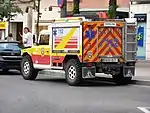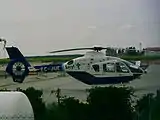Emergency medical services in Spain
Emergency Medical Services in Spain (Servicios de Emergencias Médicas, SEM) (EMS) are public services usually provided by regional Governments.[1]

Organization
Spanish organization for medical emergencies is a Public Health Integrated EMS (IEMS) that has a network of SAMU/IEMS Medical Emergency Regulation Centers (MERC = SAMU in international appellation). Emergency Primary Care and GP are fully integrated in Spanish IEMS.

Spain has 17 autonomous communities with 17 regional Health Departments. The National Health System is the agglomeration of these 17 Health Departments. So each autonomous community has its own regional IEMS that depend on Regional Health Department. Some EMS have their own staff and vehicles, others outsource the vehicles and staff to private companies. Public EMS departments usually outsource the vehicles and BLS staff. ALS staff are usually government employees.
In addition, some cities have local EMS too (e.g. SAMUR-Madrid).
There are also Emergency Medical Services in some fire departments: cities of Barcelona, Sevilla, Valencia, Zaragoza, Malaga, Bilbao, and Catalonia community. In these EMS, doctors and nurses work with firefighters in advanced life support (ALS) ambulances or helicopters.
Furthermore, non-profit organizations (Spanish Red Cross, DYA) and Civil Defense Groups provide ambulances (usually BLS) with volunteers for some situations (disasters, mass incidents, special events: sports, concerts,...)
Standards
National Minimum Staff Requirements
New legislation was published in June 2012.
| Type | Old Royal Decree 619/1998[2] | New Royal Decree 836/2012[3] | Comments |
|---|---|---|---|
| Type A: Patient Transport Ambulance | A driver and an assistant(*), when the type of service so requires | A driver (and an assistant when the type of service so requires), both with a PCP(**) (Professional Certificate of Proficiency for Emergency Technicians) | (*)Before the new legislation was enacted each region had their own training requirements for drivers and assistants: Courses from 60 to 600 hours (TTS, ATA, TEM, first aid courses...) (**)This is a certificate for employees who worked before the development of the new national qualification of EMT-B (TES) |
| Type B: BLS Ambulance (Basic Life Support Ambulance) | A driver and at least one other person with appropriate training(*) | 2 EMT-B (TES), one of them a driver | (*)Before the new legislation was enacted each region had their own training requirements for drivers and technicians: Courses from 60 to 600 hours (TTS, ATA, TEM...) |
| Type C: ALS Ambulance (Advanced Life Support Ambulance) | A driver, an emergency physician and an emergency nurse | An EMT-B/driver and an emergency nurse (and a physician when the type of service so requires) |
Usual types of ambulances and their staff
Spanish EMS is a physician led system with physicians, emergency nurses and technicians in the field. It's a two-tiered response system (Advanced Life Support with physicians and nurses,[4] and Basic Life Support with technicians).
| Type | Spanish term | Physician | Emergency Nurse | EMT (driver included) | Comments |
|---|---|---|---|---|---|
| ALS Ambulance (Advanced Life Support Ambulance or Mobile ICU) | Ambulancia de SVA (Soporte Vital Avanzado) / UVI móvil | 1 | 1 | 1-2 | - |
| ALS/ALSn Ambulance (Advanced Life Support -nursing- Ambulance) | Ambulancia SVAE (Soporte Vital Avanzado Enfermero) / SVE | 0 | 1 | 1-2 | Growing resources/only in some regions (Catalonia, Canary Islands, Basque Country, Castile-La Mancha, Andalusia and, recently, Madrid |
| BLS Ambulance (Basic Life Support Ambulance) | Ambulancia de SVB | 0 | 0 | 2 (sometimes 3) | - |
| Non-Caring Ambulance | Ambulancia no-asistencial | 0 | 0 | 1-2 | EMT-B certificate or Professional Certificate of Proficiency for emergency technicians is mandatory since June 2012 |
| HEMS (Helicopter Emergency Medical Service) | Helicóptero de Emergencias Médicas | 1 | 1 | 0 (sometimes 1) | +1 or 2 pilots |
In addition there are fast vehicles (non-ambulance) for emergency interventions:
- RRU (Rapid Response Units / VIR: Vehículo de Intervención Rápida), staffed by a driver/technician and a physician (sometimes an emergency nurse).
- Logistics and communications vehicles for disasters.
- Spanish EMS Ambulances
 Autonomous Community of Valencia EMS. SAMU-ALS Ambulance
Autonomous Community of Valencia EMS. SAMU-ALS Ambulance Madrid, city council EMS - SAMUR. BLS Ambulance
Madrid, city council EMS - SAMUR. BLS Ambulance Autonomous Community of Aragon EMS. 061 ALS and BLS Ambulances, and 112 HEMS
Autonomous Community of Aragon EMS. 061 ALS and BLS Ambulances, and 112 HEMS Autonomous Community of Madrid EMS. SUMMA 112-ALS Ambulance
Autonomous Community of Madrid EMS. SUMMA 112-ALS Ambulance
- Other EMS vehicles (non-ambulances)
 Madrid, city council EMS - SAMUR. Rapid Response Unit
Madrid, city council EMS - SAMUR. Rapid Response Unit Castilla La Mancha EMS. Logistic vehicle-Mobile medical kit
Castilla La Mancha EMS. Logistic vehicle-Mobile medical kit Madrid, city council EMS - SAMUR. Logistic vehicle
Madrid, city council EMS - SAMUR. Logistic vehicle
- Non-profit organizations/volunteers
.JPG.webp) Spanish Red Cross Ambulances (volunteers)
Spanish Red Cross Ambulances (volunteers) Spanish Red Cross Ambulance (volunteers)
Spanish Red Cross Ambulance (volunteers) DYA Ambulances (volunteers)
DYA Ambulances (volunteers) DYA Ambulance(volunteers)
DYA Ambulance(volunteers)
- Military Ambulances
 Military ambulance of the Spanish Army
Military ambulance of the Spanish Army.JPG.webp) Military Ambulance of Spanish Army
Military Ambulance of Spanish Army MOWAG Piranha IIIC ambulance of the Spanish Marines
MOWAG Piranha IIIC ambulance of the Spanish Marines
Training
| Profession | Level of education | Years | Postgraduate Education | Level of skills |
|---|---|---|---|---|
| Emergency Physician (Médico de Emergencias) | University (Degree in Medicine) | 6 years | Master of Emergency Medicine (1–2 years), Medical Specialty (4–5 years): Cardiology, Anesthesiology, Family Medicine, Intensive Care Medicine,... | ALS |
| Emergency Nurse (Enfermero de Emergencias) | University (Degree in Nursing) | 4 years | Master of Emergency Nursing (1–2 years) -optional in several regions. Nursing Specialty (2 years) (currently developing): Community nursing, Medical/Surgical Nursing,... | ALS |
| EMT/Emergency Medical Technician (EMT-basic) (TES/Técnico en Emergencias Sanitarias) | Vocational/Community college (since 2007) | 2 years | - | BLS+AED |
| Patient Transport Assistant, Patient Transport Technician, rescuer, life guard (Auxiliar de Transporte Sanitario, Técnico de Transporte Sanitario, socorrista) | Non official education before 2007/Private courses/Red Cross Courses | 4–8 weeks | - | First Aids |
Before 2007 there was not a national standard for EMT (TES/Técnico en Emergencias Sanitarias) education, so each region had their own rules (courses from 60 to 600 hours or sometimes only a first aid course; no reciprocity between regions; different terms: TTS-Técnico de Transporte Sanitario, ATTS-Auxiliar de Transporte Sanitario, ATA-Auxiliar de Transporte en Ambulancia, TEM-Técnico en Emergencias Médicas,...). Since 2007 there is a 2 years training occupational course (vocational-Community College)[5]
- Spanish HEMS
 HEMS Castilla-Leon
HEMS Castilla-Leon HEMS Galicia
HEMS Galicia HEMS Castilla-La Mancha
HEMS Castilla-La Mancha HEMS Basque Country
HEMS Basque Country
Telephone number

The emergency dial is 112 (European Emergency Number).[6] in all regions. However, the emergency number for medical services, 061, is available in several regions.
In Spain, the emergency dispatch is a physician regulated system. Each region has its own emergency call center with phone operators (telefonistas), emergency medical dispatchers (gestores de recursos/coordinadores/locutores), medical-regulators (physician) and sometimes nurses.
Curiosities
In Spain, until August, 1st 2018, the law (motor vehicle code) only allowed the police vehicles to use blue lights. Ambulances and fire engines had to use amber lights. However some ambulances used red/amber, white/amber, blue/amber, blue/red lights although this was illegal. Since that date, all emergency vehicles (police cars, ambulances, RRU, fire trucks,...) have to use blue lights. Vehicles that had amber lights have to change them within a maximum time period of two years. .[7]
See also
Sources
- "García del Águila, JJ, Mellado Vergel, FJ and García Escudero, G. Sistema integral de urgencias: funcionamientos de los equipos de emergencias en España. Emergencias, 2001, 13:326-331" (PDF) (in Spanish). Archived from the original (PDF) on 2014-01-24. Retrieved 2010-12-18.
- "REAL DECRETO 619/1998, de 17 de abril, por el que se establecen las características técnicas, el equipamiento sanitario y la dotación de personal de los vehículos de transporte sanitario por carretera. BOE, 1998, n. 101" (PDF) (in Spanish). Archived from the original (PDF) on 2010-04-04. Retrieved 2010-12-18.
- "REAL DECRETO 836/2012, de 25 de mayo, por el que se establecen las características técnicas, el equipamiento sanitario y la dotación de personal de los vehículos de transporte sanitario por carretera. BOE, 2012, n. 137" (PDF) (in Spanish). Retrieved 2012-07-06.
- Advanced life support units in Spain: the situation in 2008 E E.Pesqueira Alonso , P. Juliano Izquierdo http://www.semes.org/revista/vol21_4/6_ing.pdf
- "REAL DECRETO 1397/2007, de 29 de octubre BOE 24 noviembre de 2007 (núm. 282)" (PDF) (in Spanish). Retrieved 2010-12-18.
- "Council Decision 91/396/EEC of 29 July 1991 on the introduction of a single European emergency call number". Eur-lex.europa.eu. Retrieved 2010-12-18.
- "Todos los vehículos prioritarios en servicio de emergencia llevarán luces azules" (Press release) (in Spanish). DGT. 2010-08-08. Retrieved 2018-07-31.
External links
- SAMU 061 de Baleares
- 061 Aragón
- 061 Cantabria
- 061 Galicia
- 061 Murcia
- EPES 061
- SAMUR
- SEM sem.gencat.cat/ : (en:), (es:), (ca:) langs.
- SUMMA 112